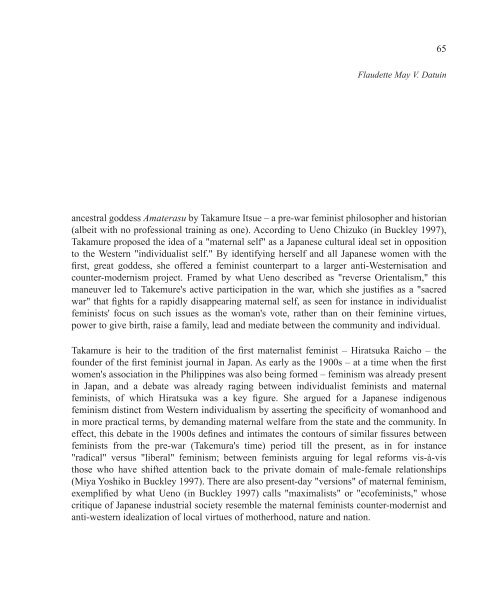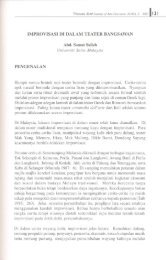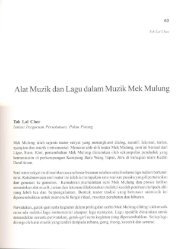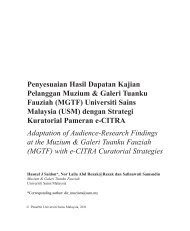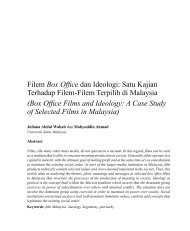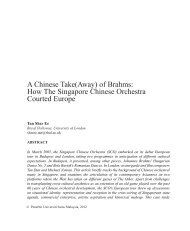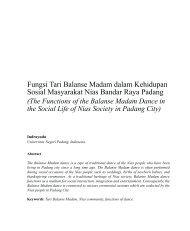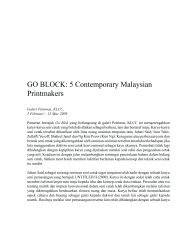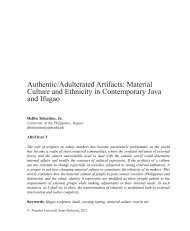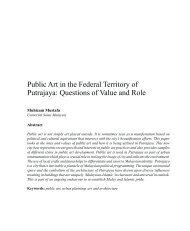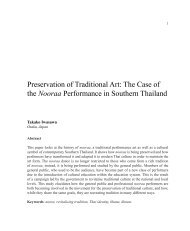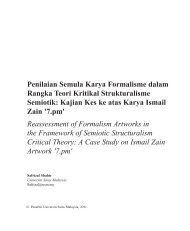Reclaiming The Healing Arts of The Ancient ... - Wacana Seni
Reclaiming The Healing Arts of The Ancient ... - Wacana Seni
Reclaiming The Healing Arts of The Ancient ... - Wacana Seni
Create successful ePaper yourself
Turn your PDF publications into a flip-book with our unique Google optimized e-Paper software.
65Flaudette May V. Datuinancestral goddess Amaterasu by Takamure Itsue – a pre-war feminist philosopher and historian(albeit with no pr<strong>of</strong>essional training as one). According to Ueno Chizuko (in Buckley 1997),Takamure proposed the idea <strong>of</strong> a "maternal self" as a Japanese cultural ideal set in oppositionto the Western "individualist self." By identifying herself and all Japanese women with thefirst, great goddess, she <strong>of</strong>fered a feminist counterpart to a larger anti-Westernisation andcounter-modernism project. Framed by what Ueno described as "reverse Orientalism," thismaneuver led to Takemure's active participation in the war, which she justifies as a "sacredwar" that fights for a rapidly disappearing maternal self, as seen for instance in individualistfeminists' focus on such issues as the woman's vote, rather than on their feminine virtues,power to give birth, raise a family, lead and mediate between the community and individual.Takamure is heir to the tradition <strong>of</strong> the first maternalist feminist – Hiratsuka Raicho – thefounder <strong>of</strong> the first feminist journal in Japan. As early as the 1900s – at a time when the firstwomen's association in the Philippines was also being formed – feminism was already presentin Japan, and a debate was already raging between individualist feminists and maternalfeminists, <strong>of</strong> which Hiratsuka was a key figure. She argued for a Japanese indigenousfeminism distinct from Western individualism by asserting the specificity <strong>of</strong> womanhood andin more practical terms, by demanding maternal welfare from the state and the community. Ineffect, this debate in the 1900s defines and intimates the contours <strong>of</strong> similar fissures betweenfeminists from the pre-war (Takemura's time) period till the present, as in for instance"radical" versus "liberal" feminism; between feminists arguing for legal reforms vis-à-visthose who have shifted attention back to the private domain <strong>of</strong> male-female relationships(Miya Yoshiko in Buckley 1997). <strong>The</strong>re are also present-day "versions" <strong>of</strong> maternal feminism,exemplified by what Ueno (in Buckley 1997) calls "maximalists" or "ec<strong>of</strong>eminists," whosecritique <strong>of</strong> Japanese industrial society resemble the maternal feminists counter-modernist andanti-western idealization <strong>of</strong> local virtues <strong>of</strong> motherhood, nature and nation.


